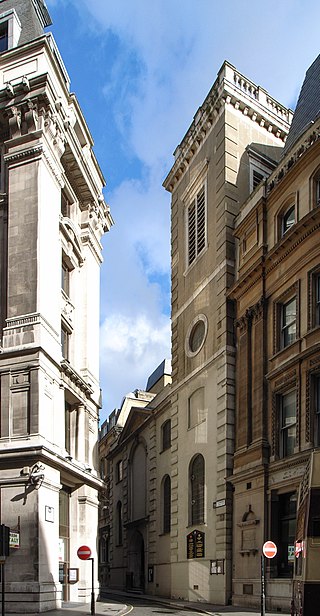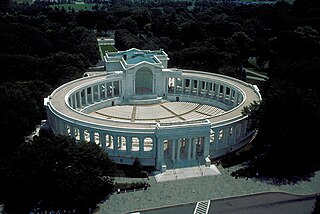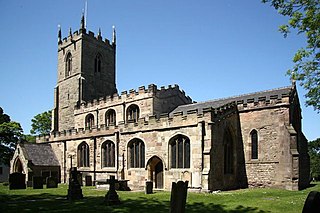
Kensal Green Cemetery is a cemetery in the Kensal Green area of North Kensington in the Royal Borough of Kensington and Chelsea and the London Borough of Hammersmith and Fulham in London, England. Inspired by Père Lachaise Cemetery in Paris, it was founded by the barrister George Frederick Carden. The cemetery opened in 1833 and comprises 72 acres (29 ha) of grounds, including two conservation areas, adjoining a canal. The cemetery is home to at least 33 species of bird and other wildlife. This distinctive cemetery has memorials ranging from large mausoleums housing the rich and famous to many distinctive smaller graves and includes special areas dedicated to the very young. It has three chapels and serves all faiths. It is one of the Magnificent Seven cemeteries in London.

A crypt is a stone chamber beneath the floor of a church or other building. It typically contains coffins, sarcophagi, or religious relics.

St Clement Eastcheap is a Church of England parish church in Candlewick Ward of the City of London. It is located on Clement's Lane, off King William Street and close to London Bridge and the River Thames.

West Norwood Cemetery is a 40-acre (16 ha) rural cemetery in West Norwood in London, England. It was also known as the South Metropolitan Cemetery. One of the first private landscaped cemeteries in London, it is one of the "Magnificent Seven" cemeteries of London, and is a site of major historical, architectural and ecological interest.

A burial vault is a container, formerly made of wood or brick but more often today made of metal or concrete, that encloses a coffin to help prevent a grave from sinking. Wooden coffins decompose, and often the weight of earth on top of the coffin, or the passage of heavy cemetery maintenance equipment over it, can cause the casket to collapse and the soil above it to settle.

The Magnificent Seven is an informal term applied to seven large private cemeteries in London. These are Kensal Green Cemetery, West Norwood Cemetery, Highgate Cemetery, Abney Park Cemetery, Brompton Cemetery, Nunhead Cemetery, and Tower Hamlets Cemetery. They were established in the 19th century to alleviate overcrowding in existing parish burial grounds as London’s population grew during the Victorian era. In 1981, the architectural historian Hugh Meller dubbed the group of cemeteries "The Magnificent Seven" after the 1960 western film of the same name.

After Abraham Lincoln was assassinated on April 14, 1865, a three-week series of events was held to mourn the death and memorialize the life of the 16th president of the United States. Funeral services, a procession, and a lying in state were first held in Washington, D.C., then a funeral train transported Lincoln's remains 1,654 miles (2,662 km) through seven states for burial in Springfield, Illinois. Never exceeding 20 mph, the train made several stops in principal cities and state capitals for processions, orations, and additional lyings in state. Many Americans viewed the train along the route and participated in associated ceremonies.

Memorial Amphitheater is an outdoor amphitheater, exhibit hall, and nonsectarian chapel located in Arlington National Cemetery in Arlington County, Virginia, in the United States. It was designed in 1913 as a replacement for the older, wooden amphitheater near Arlington House. Ground was broken for its construction in March 1915 and it was dedicated in May 1920. In the center of its eastern steps is the Tomb of the Unknown Soldier, dedicated in 1921. It has served as the site for numerous Veterans Day and Memorial Day events, as well as for memorial services and funerals for many individuals.
John Phillips was a British engineer and surveyor in the first half of the 19th century. His work and reports led to the building of London's sewage system.
A local board of health was a local authority in urban areas of England and Wales from 1848 to 1894. They were formed in response to cholera epidemics and were given powers to control sewers, clean the streets, regulate environmental health risks including slaughterhouses and ensure the proper supply of water to their districts. Local boards were eventually merged with the corporations of municipal boroughs in 1873, or became urban districts in 1894.

The pyramid of Khendjer was a pyramid built for the burial of the 13th dynasty pharaoh Khendjer, who ruled Egypt c. 1760 BC during the Second Intermediate Period. The pyramid, which is part of larger complex comprising a mortuary temple, a chapel, two enclosure walls and a subsidiary pyramid, originally stood around 37 m (121 ft) high and is now completely ruined. The pyramidion was discovered during excavations under the direction of Gustave Jéquier in 1929, indicating that the pyramid was finished during Khendjer's lifetime. It is the only pyramid known to have been completed during the 13th Dynasty.

The City of London Cemetery and Crematorium is a cemetery and crematorium in the east of London. It is owned and operated by the City of London Corporation. It is designated Grade I on the Historic England National Register of Historic Parks and Gardens.
Honouring individuals buried in Westminster Abbey has a long tradition. Over 3,300 people are buried or commemorated in the abbey. For much of the abbey's history, most of the people buried there besides monarchs were people with a connection to the church – either ordinary locals or the monks of the abbey itself, who were generally buried without surviving markers. Since the 18th century, it has become a prestigious honour for any British person to be buried or commemorated in the abbey, a practice much boosted by the lavish funeral and monument of Sir Isaac Newton, who died in 1727. By 1900, so many prominent figures were buried in the abbey that the writer William Morris called it a "National Valhalla".

St George's Chapel, formally titled The King's Free Chapel of the College of St George, Windsor Castle, at Windsor Castle in England is a castle chapel built in the late-medieval Perpendicular Gothic style. It is a Royal Peculiar, and the Chapel of the Order of the Garter. St George's Chapel was founded in the 14th century by King Edward III and extensively enlarged in the late 15th century. It is located in the Lower Ward of the castle.

The Shanghai Cobra is a 1945 mystery film directed by Phil Karlson and starring Sidney Toler as Charlie Chan.

St Michael's Cemetery is a Catholic burial ground in the Rivelin Valley area of Sheffield, South Yorkshire, England. The cemetery stands on a steep hillside on the south side of Rivelin Valley Road at its junction with Rivelin Road and Hollins Lane.

St Mary's Watford is a Church of England church in Watford, Hertfordshire, in England. It is an active church situated in the town centre on Watford High Street, approximately 25 kilometres (16 mi) outside London. St Mary's is the parish church of Watford and is part of the Anglican Diocese of St Albans. Thought to be at least 800 years old, the church contains burials of a number of local nobility and some noteworthy monumental sculpture of the Elizabethan and Jacobean eras.

St Ninian's Chapel in Braemar, Aberdeenshire, Scotland, is a Grade B listed Anglican chapel located in the grounds of the Mar Lodge Estate. Built from 1895 to 1898 for use as a private chapel by the family of Alexander Duff, 1st Duke of Fife, owners of Mar Lodge, it has been the property of the Diocese of Aberdeen and Orkney in the Scottish Episcopal Church since 1899. St Ninian's Chapel is the most westerly church in the Diocese.

The All Hallows Church is an Anglican parish church in the Diocese of Sheffield, located in Harthill, South Yorkshire, England. It is a Grade I listed building.

The King George VI Memorial Chapel is part of St George's Chapel at Windsor Castle in England. The chapel was commissioned by Elizabeth II in 1962 as a burial place for her father, George VI, and was completed in 1969. It contains the final resting places of King George VI, Queen Elizabeth The Queen Mother, Queen Elizabeth II, Prince Philip, Duke of Edinburgh, and the ashes of Princess Margaret. It was designed by George Pace.

















